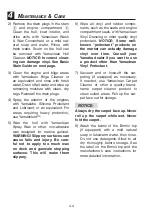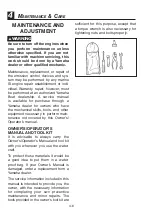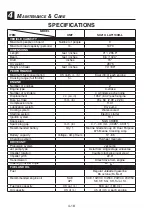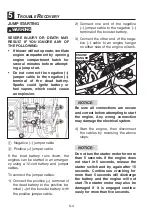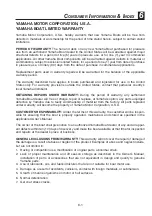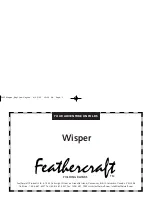
4-16
Battery electrolyte is poisonous and
dangerous, causing severe burns,
etc. It contains sulfuric acid. Avoid
contact with skin, eyes or clothing.
Antidote:
EXTERNAL – Flush with water.
INTERNAL – Drink large quantities
of water or milk. Follow with milk of
magnesia, beaten egg or vegetable
oil. Call physician immediately.
EYES – Flush with water for 15 min-
utes and get prompt medical atten-
tion.
A battery produces explosive gases.
Keep sparks, flame, cigarettes, etc.,
away. Ventilate when charging or
using in enclosed space. Always
shield eyes when working near bat-
teries.
KEEP OUT OF REACH OF CHILDREN.
Replenishing the Battery Fluid
A poorly maintained battery will deterio-
rate quickly. The battery fluid should be
checked before every outing.
Fill to the manufacturer’s recommended
level when necessary. Top up only
with distilled water (or pure de-ion-
ized water) suitable to use in batteries.
NOTICE:
Normal tap water contains
minerals which are harmful to a bat-
tery; therefore, refill only with dis-
tilled water.
Recharging
• When charging the battery, keep it
well away from sparks and open
flames, as it gives off explosive
gases.
• When using a battery charger,
connect the battery to the charger
before you turn on the charger.
This will prevent sparking at the
terminals that could ignite battery
gases.
• If jump-starting the engine is
necessary in an emergency, fol-
low the instructions on page 5-4.
Improper jump-starting could
cause sparking and explosion.
1) Remove the caps from the cells. Add
distilled water if necessary to top up
the electrolyte to the proper level.
2) Follow the battery manufacturer’s
instructions for charging.
Connecting the Battery Terminals
Always make sure the connections are
correct when you install the battery in
the boat. Make sure that the breather
pipe is properly connected and that it is
not damaged or obstructed.
WARNING
WARNING
4
M
AINTENANCE
& C
ARE



